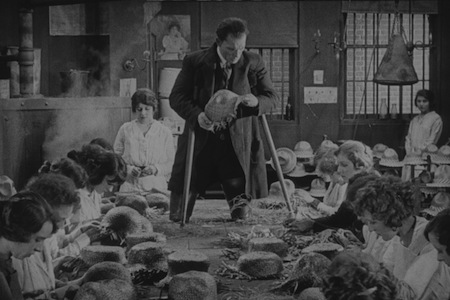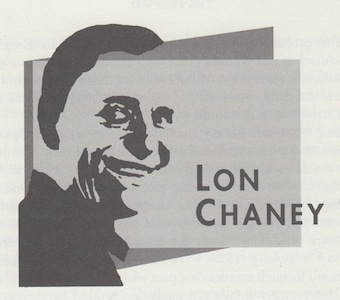Born: April 1, 1883, Colorado Springs, CO
Died: August 26, 1930, Los Angeles, CA
No matter how grotesque the makeup was, you kept watching him.
—Michael Blake
Like many other actors in the silent era, Lon Chaney came to personify an image that audiences would never relinquish. He made the most indelible impression on horror films of any actor, and his name became synonymous with a genre that has remained one of film’s most mesmerizing. The child of deaf-mute parents, he learned to master the art of pantomime, joined his brother as a propman in a traveling stage show and rose through Hollywood’s ranks to become a legendary chameleon known best as “the man of a thousand faces.”
Beginning as an extra in 1913, Chaney took any bit part he could land, and before long he had made over seventy films. A memorable role in The Miracle Man (1919) made him a star. His extraordinary talents attracted director Tod Browning, who used Chaney extensively in such films as Wicked Darling (1919), The Unholy Three (1925), The Blackbird (1926) and The Road to Mandalay (1926). In The Unknown (1927), he played an armless knife-thrower who dazzles circus crowds with his feet; a startled Joan Crawford was his favorite target. Conversely, he played a man whose legs had been amputated in West of Zanzibar (1928); Browning liked the effect so much that he used a legless character in Freaks years later.
By the early twenties, Chaney’s pictures were made on his terms; he was powerful enough to choose his own director and command complete script approval. That probably accounts for the adaptation of Victor Hugo’s piercing novel Hunchback of Notre Dame (1923). Stripped of its politics and left with the relationships, it reflects the nature of Chaney himself: nonconfrontational. This fundamental story of maiden and monster is the origin for all imitations, including Chaney’s own later films.
In another Beast and Beauty story, The Phantom of the Opera (1925), Chaney demonstrated his profound influence with the stiff, slow movements of the title character. These jerking, eccentric motions, usually accompanied by the display of outstretched, clawing hands, would later influence the character shadings of Dracula and Frankenstein. His compelling performances in these grotesque roles put him forever in the nightmares of horror fans.
A trademark of Chaney’s films was incredible physical transformations, beginning in The Penalty (1920) when he strapped his legs behind his body and put himself through excruciating pain when leaping off tables to land on his knees. However, a common misconception is that Chaney was a reckless contortionist who put celluloid in his cheekbones and pins in his nose for roles like the Phantom. A proclaimed seventy-pound rubber hump for Notre Dame, for example, was actually revealed to be just twenty pounds of plaster. Although his disfigurements were complicated and strenuous, they certainly were not masochistic; such stories were exaggerated and perpetuated by studio executives to heighten interest in his pictures.
In the 1929 edition of the Encyclopedia Britannica, Chaney generously contributed a general description of contemporary motion picture makeup techniques. However, he left out many details; by leaving fans to speculate on the methods behind his particular transformations, he prolonged the life of his illusions. In fact, Chaney was careful not to let his characterizations rely heavily on makeup. He developed a great screen presence, using his ability to examine the darkest aspects of the human condition. In one of his biggest hits, Tell It to the Marines (1927), he used no disguise at all, and the critical response was tremendous.
Dual roles also became another trademark, as in the lost film London After Midnight (1927), where vampire and policeman roles are both played by Chaney. Carefully picking a project for his debut into the sound era, he filmed a remake of The Unholy Three (1930), in which Chaney played all of the leading characters. The film opened to rave reviews and instant box office success. He had made a brilliant transition to talkies and was ready for a new challenge. Unfortunately, The Unholy Three was his last picture and his only sound effort. Shortly before his death, Chaney was set to work with Tod Browning on a sound version of Dracula (1931). Universal Pictures had acquired the rights to the Broadway play, a box office smash starring an unknown named Bela Lugosi. When throat cancer claimed Chaney’s life in 1930, at the age of forty-seven, the role of the famous count reverted to Lugosi.
Unfortunately, the gallant efforts of film preservationists have failed to keep many of Chaney’s films in front of film fans. Of his 150 spectacular films, a paltry forty-three still exist [at the time of writing of the 1998 essay], many of them fragmented or in jeopardy of permanent damage from the effects of nitrate chemicals. James Cagney performed scenes that Chaney had originated in tribute to the master of horror entitled The Man of a Thousand Faces (1957). And though Creighton Chaney, son of his first marriage to Cleva Creighton, would keep the horror alive through his performances as “Lon Chaney Jr.,” he could not match his father’s macabre characters. Lon Chaney’s unique performances are still the standard among screen entertainers. The humanistic view of monsters and freaks set a precedent for screen portrayals from Boris Karloff’s Frankenstein to Steven Spielberg’s ET.
At Chaney’s funeral, Irving Thalberg gave the eulogy, saying, “There are few who possess his peculiar magic, that extraordinary ability to make us feel, to lift us out of our own existence and make us believe in the world of make-believe. But let’s examine him closely, look behind the makeup, the many masks, and see what happened to this strange and interesting man to give him those sharp edges, those facets that made him glitter, that made him great. Great not only because of his God-given talent but because he used that talent to illuminate certain dark corners of the human spirit.”
To read all the republished articles from ‘The Film 100,’ go to Reintroducing the Film 100 here on Keyframe.





